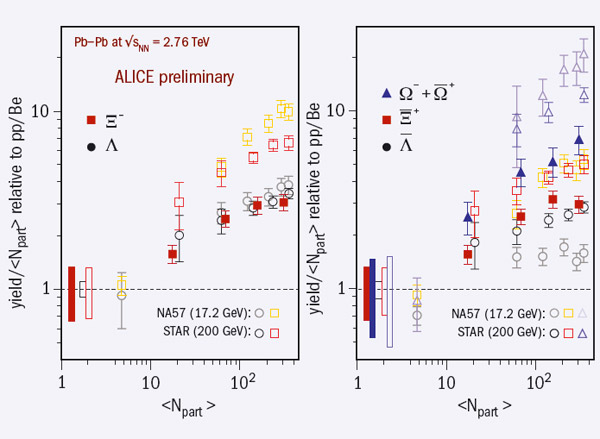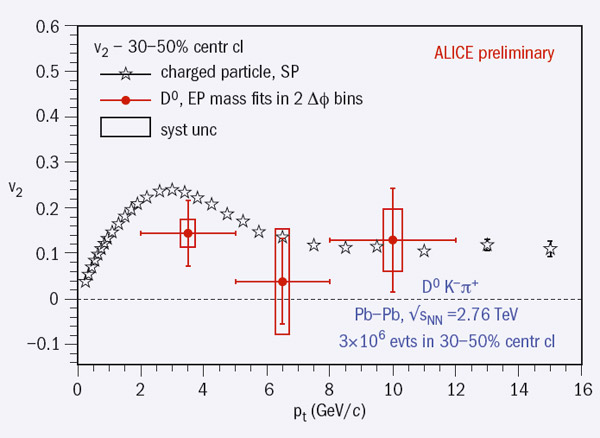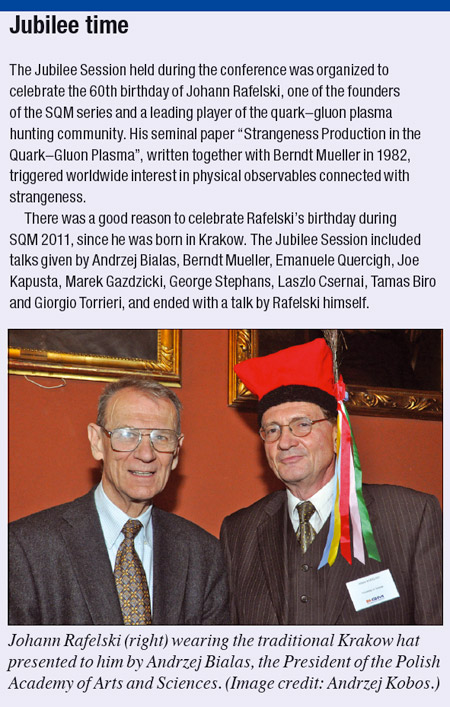The latest news on strangeness in heavy-ion collisions.

The 13th international conference on Strangeness in Quark Matter (SQM 2011) took place in Krakow on 18–24 September. Organized by the Polish Academy of Arts and Sciences (Polska Akademia Umiejętności, PAU), it attracted more than 160 participants from 20 countries. The emphasis was on new data on the production of strangeness and heavy flavours in heavy-ion and hadronic collisions, in particular the new results from the LHC at CERN and the Relativistic Heavy Ion Collider (RHIC) at Brookhaven. With the new high-quality data on identified particles, SQM 2011 in a sense supplemented the Quark Matter conference that was held in Annecy in May.
Summary talks during the first two morning sessions introduced the experimental highlights for the main heavy-ion experiments currently in operation. They included data at energies ranging from the Heavy Ion Synchrotron (SIS) at GSI (the HADES and FOPI experiments), through the Super Proton Synchrotron at CERN (NA49 and NA61) and RHIC (PHENIX and STAR), up to the LHC (ALICE, ATLAS and CMS), as well as prospects for new or future facilities, such as the Facility for Antiproton and Ion Research (FAIR) and the Nuclotron-based Ion Collider Facility (NICA).
In this report we can cover only a small selection of the impressive wealth of new results and information presented at the conference. The following highlights illustrate some of the most recent measurements in nucleus–nucleus collisions at the LHC and in the Beam Energy Scan programme at RHIC. All of them focus on results obtained in the sectors of strange and heavy quarks, which traditionally form the major part of the discussions at SQM conferences.
Experimental results
Maria Nicassio of the University and INFN Bari for the ALICE collaboration presented preliminary results on the production of the charged multi-strange hadrons Ξ–and Ω– and their antiparticles, from peripheral to the most central lead–lead collisions at the current maximum centre-of-mass energy of 2.76 TeV per equivalent nucleon–nucleon (SUSY: the search continues). The enhancement of these particle yields normalized to the number of nucleons participating in the collision and compared with proton–proton (pp) production was shown for the first time (figure 1). As already found in heavy-ion collisions at the SPS and RHIC, the yields at the LHC cannot be achieved in a hadronic phase only, but require a fast equilibration and a large correlation volume. For these reasons, the enhanced production of multi-strange baryons is regarded as one of the signals for the phase transition from ordinary hadronic matter to the quark–gluon plasma (QGP). It was also stressed that, although the absolute production of hyperons increases with energy from RHIC to the LHC, both in heavy-ion and in pp collisions, the relative enhancement decreases as a result of a significant increase in pp yields at the LHC.

Using the Beam Energy Scan at RHIC, the STAR collaboration has progressed significantly with tackling the evolution of the collective effects observed in heavy-ion (Au–Au) collisions between √sNN=7.7 GeV and 62.4 GeV, as Shusu Shi of Central China Normal University showed. While studying the excitation function of the second harmonic v2 in the azimuthal distribution of particle (π, K, p and Λ) production, the collaboration identified a significant difference in the behaviour of particles and antiparticles for 0–80% central Au–Au reactions (figure 2). The increasing deviation in v2 between particles and antiparticles, observed with decreasing √sNN, is more pronounced for baryons, such as protons and Λs, than for mesons (charged π and K). However, it must be noted that above 39 GeV, the difference in v2 between particles and antiparticles remains almost constant to higher energies at about 5–10%. The large difference between particle and antiparticle v2 at lower energies could thus be related to an increased amount of transported quarks to mid-rapidity or it could indicate that hadronic interactions become dominant below 11.5 GeV. In the latter case, the difference in v2 could be attributed to different interaction cross-sections of particles and antiparticles in hadronic matter of high baryon density.

The ALICE collaboration also presented preliminary results on the azimuthal anisotropy (v2) of charm production in non-central lead–lead collisions at the LHC, in a talk by Chiara Bianchin of the University and INFN Padova. Such a measurement was highly anticipated, after the observation of a large suppression of charmed-meson yields in nucleus–nucleus collisions, which implies strong quenching of charm quarks in dense QGP. The study of charm anisotropy would provide insight on the degree of thermalization of the quenched charm quarks within QGP. Figure 3 shows the v2 parameter of D0 mesons, reconstructed in the K–π+ channel, as a function of transverse momentum (in red), compared with that of charged hadrons (in black). This measurement, though statistically limited, hints at a non-zero charm v2 at low momentum and bodes well for the continuation of the study with the higher-luminosity lead run in 2011.
Theoretical discussions
The conference witnessed a lively debate on theoretical issues. In the theoretical summary talk, Giorgio Torrieri of the Goethe University, Frankfurt, pointed to various differences in the interpretation of heavy-ion data (e.g. equilibrated vs non-equilibrated hadron gas; statistical vs non-statistical production in small systems). Probably everyone connected with the SQM conferences is enthusiastic about the fact that statistical models do an excellent job in describing hadron production in heavy-ion and hadronic collisions, with the key role being played by the fast strange-quark thermalization. Perhaps, this attitude just defines the SQM community. On the other hand, there exist differences in the approaches and interpretations that should be resolved if the community is to gain a better understanding of hadron production processes. The relatively low proton-to-pion production ratio measured recently by ALICE, presented by Alexander Kalweit of the Technische Universität Darmstadt, will trigger such attempts.

The analysis of the data has led to a physical picture that may be regarded as a kind of standard model of relativistic heavy-ion collisions. This model is based on the application of relativistic hydrodynamics combined with the modelling of the initial state on one side, supplemented by the kinetic simulations of freeze-out on the other side. From the theoretical point of view, it is not completely clear how strange particles may be accommodated into this picture, both at RHIC and at the LHC. The results obtained from 2+1 dissipative hydrodynamics, presented by Piotr Bozek of the Institute of Nuclear Physics, Krakow, indicate that the multi-strange particle spectra measured at the LHC cannot be simply reproduced in hydrodynamic calculations that are constructed to describe ordinary hadrons, such as pions, kaons and protons. The new LHC measurement of the elliptic flow of D0 mesons shown in figure 3 will be another important input for hydrodynamic and energy-loss models. As Christoph Blume of the University of Heidelberg indicated, the general concept that strange particles are emitted much earlier than other more abundant hadrons may be challenged in attempts to achieve a uniform description of several observables simultaneously.
Another theoretical activity presented at SQM 2011 was triggered by low-energy experiments aimed at finding the critical point of QCD (RHIC Beam Energy Scan, NA61, FAIR, NICA). This critical point marks the end of the alleged first-order phase transition in the QCD phase diagram. Its position is suggested by the effective models of QCD and lattice QCD simulations. These two approaches suffer from fundamental problems but, nevertheless, deliver useful physical insights. For example, as Christian Schmidt of the Frankfurt Institute for Advanced Studies showed, the lattice QCD calculations suggest that the curvature of the chiral phase-transition line is smaller than that of the freeze-out curve. Moreover, the lattice results are in agreement with the STAR data on net-proton fluctuations. As Krzysztof Redlich of the University of Wroclaw pointed out, theoretical probability distributions of conserved charges may be compared directly with the distributions measured by STAR to probe the critical behaviour.
The last day of the meeting was the occasion for more experimental highlights, presented in the summary talk by Karel Safarik of CERN. The conference ended with a presentation by Orlando Villalobos-Baillie of the next SQM meeting, which will be held in Birmingham, UK, in 2013.
Andrzej Bialas, the founder and the leader of the high-energy physics theoretical group in Krakow, who is currently the president of PAU, was the honorary chair of the conference. The organization chairs were Wojtek Broniowski and Wojtek Florkowski of Jan Kochanowski University, Kielce, and the Institute of Nuclear Physics, Krakow.





